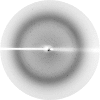Crystallization and preliminary X-ray diffraction analysis of the hyperthermophilic Sulfolobus solfataricus phosphotriesterase
- PMID: 17620708
- PMCID: PMC2335143
- DOI: 10.1107/S1744309107023512
Crystallization and preliminary X-ray diffraction analysis of the hyperthermophilic Sulfolobus solfataricus phosphotriesterase
Abstract
Organophosphates constitute the largest class of insecticides used worldwide and some of them are potent nerve agents. Consequently, organophosphate-degrading enzymes are of paramount interest as they could be used as bioscavengers and biodecontaminants. Phosphotriesterases (PTEs) are capable of hydrolyzing these toxic compounds with high efficiency. A distant and hyperthermophilic representative of the PTE family was cloned from the archeon Sulfolobus solfataricus MT4, overexpressed in Escherichia coli and crystallized; the crystals diffracted to 2.54 A resolution. Owing to its exceptional thermostability, this PTE may be an excellent candidate for obtaining an efficient organophosphate biodecontaminant. Here, the crystallization conditions and data collection for the hyperthermophilic S. solfataricus PTE are reported.
Figures
Similar articles
-
Crystallization and preliminary X-ray diffraction analysis of the hyperthermophilic Sulfolobus islandicus lactonase.Acta Crystallogr Sect F Struct Biol Cryst Commun. 2011 Mar 1;67(Pt 3):354-7. doi: 10.1107/S1744309110053819. Epub 2011 Feb 25. Acta Crystallogr Sect F Struct Biol Cryst Commun. 2011. PMID: 21393842 Free PMC article.
-
Structural basis for natural lactonase and promiscuous phosphotriesterase activities.J Mol Biol. 2008 Jun 20;379(5):1017-28. doi: 10.1016/j.jmb.2008.04.022. Epub 2008 Apr 16. J Mol Biol. 2008. PMID: 18486146
-
A thermostable phosphotriesterase from the archaeon Sulfolobus solfataricus: cloning, overexpression and properties.Extremophiles. 2005 Aug;9(4):297-305. doi: 10.1007/s00792-005-0445-4. Epub 2005 May 21. Extremophiles. 2005. PMID: 15909078
-
The alpha-L-fucosidase from Sulfolobus solfataricus.Extremophiles. 2008 Jan;12(1):61-8. doi: 10.1007/s00792-007-0105-y. Epub 2007 Aug 9. Extremophiles. 2008. PMID: 17687508 Review.
-
Detoxification of organophosphate nerve agents by bacterial phosphotriesterase.Toxicol Appl Pharmacol. 2005 Sep 1;207(2 Suppl):459-70. doi: 10.1016/j.taap.2005.02.025. Toxicol Appl Pharmacol. 2005. PMID: 15982683 Review.
Cited by
-
Structural determinants of the high thermal stability of SsoPox from the hyperthermophilic archaeon Sulfolobus solfataricus.Extremophiles. 2009 May;13(3):461-70. doi: 10.1007/s00792-009-0231-9. Epub 2009 Feb 27. Extremophiles. 2009. PMID: 19247785
-
Crystallization and preliminary X-ray diffraction analysis of the hyperthermophilic Sulfolobus islandicus lactonase.Acta Crystallogr Sect F Struct Biol Cryst Commun. 2011 Mar 1;67(Pt 3):354-7. doi: 10.1107/S1744309110053819. Epub 2011 Feb 25. Acta Crystallogr Sect F Struct Biol Cryst Commun. 2011. PMID: 21393842 Free PMC article.
-
Organophosphorus-degrading bacteria: ecology and industrial applications.Nat Rev Microbiol. 2009 Feb;7(2):156-64. doi: 10.1038/nrmicro2050. Epub 2008 Dec 22. Nat Rev Microbiol. 2009. PMID: 19098922 Review.
-
Rational engineering of a native hyperthermostable lactonase into a broad spectrum phosphotriesterase.Sci Rep. 2017 Dec 1;7(1):16745. doi: 10.1038/s41598-017-16841-0. Sci Rep. 2017. PMID: 29196634 Free PMC article.
-
Signal Disruption Leads to Changes in Bacterial Community Population.Front Microbiol. 2019 Mar 29;10:611. doi: 10.3389/fmicb.2019.00611. eCollection 2019. Front Microbiol. 2019. PMID: 30984139 Free PMC article.
References
-
- Afriat, L., Roodvelt, C., Manco, G. & Tawfik, D. (2006). Biochemistry, 45, 13677–13686. - PubMed
-
- Aubert, S. D., Li, Y. & Raushel, F. M. (2004). Biochemistry, 43, 5707–5715. - PubMed
-
- Collaborative Computational Project, Number 4 (1994). Acta Cryst. D50, 760–763. - PubMed
-
- Cowtan, K. D. & Zhang, K. Y. (1999). Prog. Biophys. Mol. Biol.72, 245–270. - PubMed
Publication types
MeSH terms
Substances
LinkOut - more resources
Full Text Sources
Other Literature Sources



